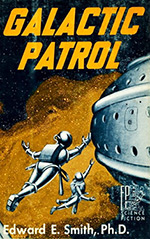
![]() couchtomoon
couchtomoon
9/4/2014
![]()
Blinding blue blazes, if this book doesn't clear ether, I'm going to!
It took me a week or two (maybe three?) to trudge through this serialized space opera about an honorable and righteous space police brigade that has the power to read minds. (Talk about a civil rights nightmare! Someone call the Galactic Civil Liberties Union!) I'm not sure how this novel would interest anyone other than an 11-year-old boy from the 1940's, but that's exactly why this series is so highly regarded. As boring as I found it, Galactic Patrol most definitely bears its signature on our most celebrated works in SF, as those 11-year-old boys grew up to become very popular SF writers and directors.
Fresh from graduation at the Patrol Academy, Lensman Kimball Kinnison is given the task of piloting the Patrol's most advanced spaceship, theBrittania, against those space pirate rascals, the Boskonians, who have more advanced space drive technology. During his mission, Kinnison takes a side trip and frees a mentally enslaved race of croco-snake people, thus winning some powerful allies. Immediately upon his return to Earth, Kinnison is promoted to Gray Lensman, which means the Patrol has given him free rein to do whatever he wants because they completely trust his capabilities and judgment. The Patrol is also willing to provide him with whatever resources he desires for whatever tasks he chooses to pursue. Naturally, Kinnison decides to track down his pirate enemies again, but first undertakes some deep mental training to better utilize his powerful telepathic lens. Then, he gets promoted again, judges a murder trial (huh?), recovers a pirate space drive, and the story ends on a cliffhanger with the pirate leader. And somewhere in all of this, he winds up in the hospital where he mistreats and verbally abuses his nurse, Clarissa, "a real beauty—a knockout—a seven-sector callout..." (ch. 17), who, we pick up from context, is set up to be Kinnison's mate in an Arisian breeding program to create more amazing future Lensmen, just like Kinnison. Because Kinnison is uh-may-zing.
There's definitely some of that Star Wars/Star Trek/Foundation vibe in this novel, with the perfect, young hero working for a good and just galactic agency, where alien cultures interact, tolerate, support, and collide with one another. Kinnison's moments on Arisia, where he undertakes advanced lens training bring to mind Luke's moments with Obi-Wan and Yoda. (I think. I haven't seen a Star Wars movie in nearly two decades.) Kinnison also has some of that Captain Kirk bravado although, because this was written for 11-year-olds, he doesn't get much lady action. Maybe that happens in the later novels.
The lens itself is a clever little device to deal with those nasty little plot holes that are often neglected in space operas: language barriers, transgalactic communications, navigational hazards in unknown space. The lenses endow wearers with telepathy, in order to communicate with alien peoples, communicate across stretches of space, and provide some other vague powers that are probably better explored in later books. The lenses are restricted only to "lens-worthy" individuals, such as the awesome Mr. Perfect Kimball Kinnison, which excludes most humans, and includes some non-humans. The relationship between the lens and its wearer is somewhat exclusive, meaning no one else can tamper with or steal the lens. Considering that many modern series fail to explain the possibility of intergalactic communications with never-before-seen alien life (I'm looking at you,Star Trek), this early space opera succeeds in addressing this issue, although the technology offered to explain such a feat makes little sense.
Having read this entire novel, I admit that I am still murky on exactly what this magical telepathic lens looks like, although I picture it like this:

Of the two 1930's space operas I have sampled so far, Burroughs'Carson of Venus is definitely more fun, but that may only be due to its placement in the series. Galactic Patrol is set as a mid-series installment of the Lensman series, but only because of the addition of two later written prequels: Triplanetary (written in 1934, but revised in 1948 to include a connection to this series), and First Lensman (1950). Galactic Patrol feels like an introductory novel, where the brunt of the text is primarily dedicated to setting up the world and the characters, despite Kinnison's shuttling all over space. The novel ends on a cliffhanger, which suggests more interesting action may occur in later novels. On the other hand, Carson of Venus is a true mid-series novel, where the boring setups likely occurred in the earlier novels, leaving the reader to enjoy a mid-series plot arc with firmly established character relationships. I might have enjoyed the Lensman series more if I had sampled a later novel.
Despite that, I must say that Kimball Kinnison is probably the best space opera character name ever, with the exception of his son (who appears later in the series), Kit Kinnison. Great character naming, Doc.
Obviously, I didn't take this novel very seriously. Recommended only for die hard pulp space opera fans, and SF completists. I'll pass on the rest of the series.
http://couchtomoon.wordpress.com